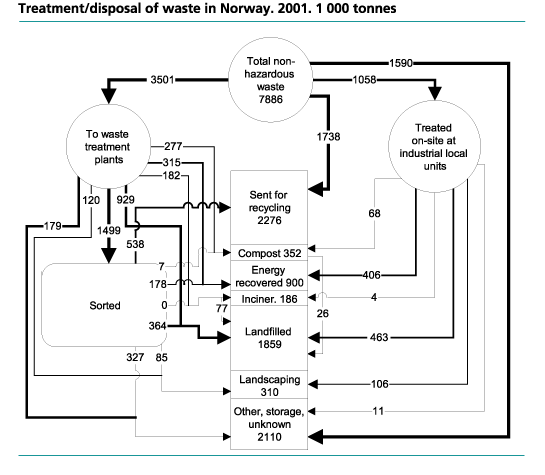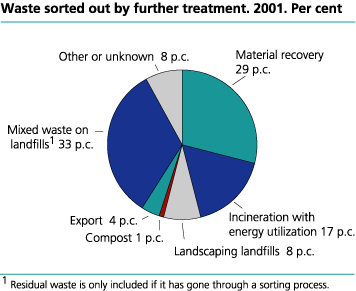Content
Published:
This is an archived release.
28 per cent less landfilled waste
28 per cent less waste was landfilled in 2001 than in 1998. In the same period, amounts to incineration and composting increased by 42 and 186 per cent respectively. The number of approved landfills decreased by 25 per cent, while there are now more than twice as many incineration plants in Norway as in 1998.
From 1998 to 2001 amounts of waste to final disposal, i.e. landfill or incineration without energy recovery, were reduced by 23 per cent. On-site treatment in manufacturing industries is excluded from this. If on-.site treatment is included, a total of 2 million tonnes of waste were given final disposal, corresponding to nearly 26 per cent out of a total of 7.9 mill tonnes of waste generated, see Waste accounts 2000
| Treated by plant1,2. 1992-2001. 1 000 tonnes |
| Year | Biological treatment | Landfill | Incineration | ||||||||||||||||||||||||||||||||||||
|---|---|---|---|---|---|---|---|---|---|---|---|---|---|---|---|---|---|---|---|---|---|---|---|---|---|---|---|---|---|---|---|---|---|---|---|---|---|---|---|
| Total | Energy utilization3 | Without energy utilization | |||||||||||||||||||||||||||||||||||||
| 1992 | 21 | 1 687 | 342 | 250 | 92 | ||||||||||||||||||||||||||||||||||
| 1995 | 52 | 1 895 | 493 | 360 | 133 | ||||||||||||||||||||||||||||||||||
| 1998 | 99 | 1 928 | 470 | 343 | 127 | ||||||||||||||||||||||||||||||||||
| 2001 | 284 | 1 396 | 669 | 489 | 181 | ||||||||||||||||||||||||||||||||||
| 1 | Excluding waste incinerated or landfilled by industrial local units. |
| 2 | Waste for material recovery not included. |
| 3 |
Calculated from an avery energy recovery rate of 73 per cent at Norwegian waste
incineration plants. |
| Source: Statistics Norway. | |
16 per cent sorted
Out of the 1 255 000 tonnes, or 16 per cent, of waste sent to sorting plants, 59 per cent was sorted out in recyclable fractions, of which the largest was 187 000 tonnes of paper and board and 177 000 tonnes of wood. 41 per cent remained mixed, so-called sorting residues.
About one third of the sorted waste was sent for recycling, 34 per cent was landfilled and 17 per cent was energy recovered.
Stable recycling percentage
Nearly 2.,3 million tonnes of waste was recycled in 2000, see Waste accounts 2000 . This is about the same level as the year before.
More recovery, less landfill
284 000 tonnes of waste was composted in 2001, which is 185 000 tonnes more than in 1998. The amounts incinerated increased by 204 000 tonnes to 674 000 tonnes in the same period. 1.,4 million tonnes of waste was landfilled in 2001, which is 500 000 tonnes less than in 1998. On-site treatment in manufacturing industries is excluded in these figures
The number of landfills is reduced from 149 in 1998 to 112 in 2001. In the same period, several new incineration plants were introduced, so that in 2001, 20 incineration plants were registered compared with 9 in 1998.
The figures are the results from a survey on waste treatment plants in Norway. In the survey, special attention was paid to construction and demolition waste, and figures for this are published at http://www.ssb.no/english/subjects/01/05/
Tables:
- Table 1 Landfill. 2001. 1 000 tonnes
- Table 2 Waste incineration. 2001. Tonnes
- Table 3 Composting. 2001. Tonnes
- Table 4 Amounts sorted out by sorting plants and other plants, by material. 2001. Tonnes
- Table 5 Waste sorted out by further treatment. 2001. Tonnes
- Table 6 Number of plants, by treatment. 1992-2001. Tonnes
Contact
-
Camilla Skjerpen
E-mail: camilla.skjerpen@ssb.no
tel.: (+47) 48 22 72 14
-
Mona E. Onstad
E-mail: mona.onstad@ssb.no
tel.: (+47) 48 59 61 86


